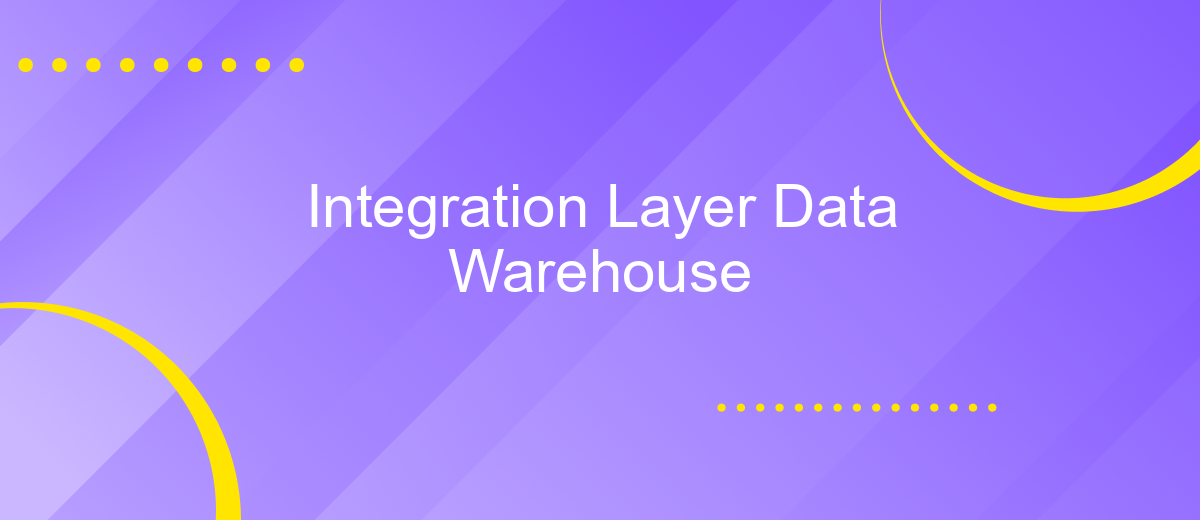Integration Layer Data Warehouse
The integration layer in a data warehouse plays a pivotal role in consolidating data from diverse sources into a unified repository. This layer ensures data consistency, quality, and accessibility, enabling organizations to perform comprehensive analyses and make informed decisions. By seamlessly integrating disparate datasets, the integration layer enhances the overall efficiency and reliability of the data warehousing process.
Introduction
The integration layer in a data warehouse serves as a crucial component that consolidates data from various sources into a unified repository. This layer ensures that the data is cleaned, transformed, and harmonized to provide a consistent view across the organization. By effectively managing data integration, businesses can derive actionable insights and make informed decisions.
- Data Consolidation: Aggregates data from multiple sources.
- Data Transformation: Converts data into a standardized format.
- Data Cleansing: Removes inconsistencies and errors.
- Data Harmonization: Ensures uniformity across datasets.
Implementing an efficient integration layer is essential for leveraging the full potential of a data warehouse. It not only enhances data quality but also improves the reliability of analytical outcomes. As organizations increasingly rely on data-driven strategies, the role of the integration layer becomes even more critical in ensuring seamless and accurate data flow.
Data Integration Layer

The Data Integration Layer serves as a crucial component in a data warehouse architecture, enabling seamless data flow from various sources into a unified repository. This layer ensures that data from disparate systems, such as databases, APIs, and flat files, is extracted, transformed, and loaded (ETL) efficiently. By standardizing and cleaning the data, the integration layer guarantees consistency and accuracy, which are essential for reliable business intelligence and analytics. Tools like ETL software and middleware solutions play a critical role in automating these processes, reducing manual efforts and minimizing errors.
One effective tool for managing data integrations is ApiX-Drive, a service designed to simplify the setup of data pipelines between various applications. ApiX-Drive offers a user-friendly interface and robust features that allow users to configure integrations without extensive technical knowledge. By leveraging such services, organizations can streamline their data integration processes, ensuring timely and accurate data availability for decision-making. This not only enhances operational efficiency but also provides a scalable solution to accommodate growing data needs.
Data Warehouse

A Data Warehouse (DW) is a centralized repository designed to store large volumes of structured data from various sources. It facilitates data analysis, reporting, and business intelligence activities by providing a unified and consistent data view. Data warehouses are optimized for read-heavy operations and complex queries, making them an essential component for decision-making processes in organizations.
- Data Integration: Aggregates data from multiple sources into a single repository.
- Data Cleaning: Ensures data quality by removing inconsistencies and errors.
- Data Transformation: Converts data into a suitable format for analysis.
- Data Storage: Utilizes optimized storage techniques for efficient data retrieval.
- Data Access: Provides tools and interfaces for querying and reporting.
Implementing a data warehouse involves several steps, including data extraction, transformation, and loading (ETL) processes. These steps ensure that the data is accurate, consistent, and readily available for analysis. By centralizing data from disparate sources, a data warehouse enhances data accessibility and provides valuable insights, driving informed business decisions and strategic planning.
Benefits and Challenges

Implementing an Integration Layer in a Data Warehouse offers numerous benefits, including streamlined data management and enhanced data quality. By consolidating data from various sources, it ensures consistency and reliability, making it easier for organizations to derive actionable insights. Moreover, it supports real-time data integration, which is crucial for timely decision-making.
However, the process is not without its challenges. One of the primary hurdles is the complexity of integrating data from disparate sources, each with its own format and schema. Additionally, maintaining data security and compliance during integration is a significant concern, especially with the increasing regulations around data privacy.
- Improved data consistency and quality
- Real-time data integration capabilities
- Enhanced decision-making processes
- Streamlined data management
In conclusion, while the Integration Layer in a Data Warehouse brings substantial advantages, it also requires careful planning and execution to overcome the associated challenges. Organizations must invest in robust integration tools and strategies to fully leverage its potential and ensure seamless data flow across the enterprise.


Conclusion
In conclusion, the Integration Layer of a Data Warehouse plays a crucial role in ensuring seamless data flow and consistency across an organization's various data sources. By effectively integrating disparate data streams, businesses can achieve a unified view of their data, leading to more informed decision-making and enhanced operational efficiency. The integration layer not only consolidates data but also ensures its quality and reliability, which are essential for accurate analytics and reporting.
Moreover, leveraging tools like ApiX-Drive can significantly simplify the process of setting up and managing integrations. ApiX-Drive offers a user-friendly interface and robust functionalities that allow businesses to automate data synchronization between different applications and services without the need for extensive technical expertise. This not only saves time and resources but also ensures that data integration processes are scalable and adaptable to changing business needs. Ultimately, a well-implemented integration layer, supported by efficient tools, is foundational to the success of any data-driven organization.
FAQ
What is an Integration Layer in a Data Warehouse?
Why is an Integration Layer important for a Data Warehouse?
How does the Integration Layer handle data from different sources?
Can the Integration Layer automate data integration processes?
What are the challenges associated with the Integration Layer in a Data Warehouse?
Apix-Drive will help optimize business processes, save you from a lot of routine tasks and unnecessary costs for automation, attracting additional specialists. Try setting up a free test connection with ApiX-Drive and see for yourself. Now you have to think about where to invest the freed time and money!

